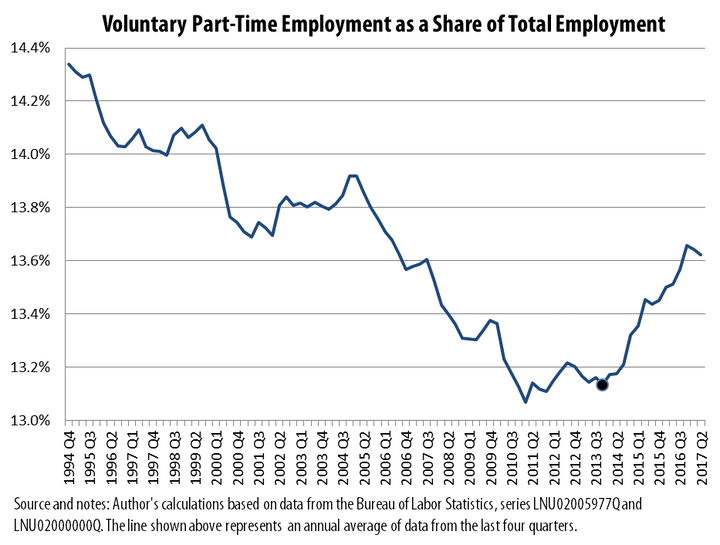Earlier this year, economist Dean Baker penned a column in HuffPost arguing that the Affordable Care Act – a.k.a., “Obamacare” – has enhanced workers’ freedom by allowing them to cut back on their weekly hours. Baker argued that before the Affordable Care Act, many Americans were stuck working longer hours than they wanted simply for the health insurance benefits. According to Baker, after the ACA was passed, many of these workers were finally able to voluntarily cut back on their hours; instead of working 40 hours a week to qualify for their employer’s health insurance plan, workers could instead work part-time and buy a plan on the ACA exchanges.
There is some relatively straightforward evidence for this view. Specifically, since the fourth quarter of 2013 – the last quarter before the ACA’s health insurance expansion went into effect – there has been a noticeable uptick in voluntary part-time employment. (“Voluntary” part-time employees are those who choose to work less than 35 hours per week.) Moreover, this increase came after nearly 20 straight years of falling voluntary part-time employment, as can be seen in the figure below:

But beyond a cursory glance at the data, is there any evidence that the ACA is causing this surge in voluntary part-time employment? And are any neutral, unbiased referees supporting this assertion? As it happens, there is one: the Congressional Budget Office (CBO).
In February 2014, the CBO released its normal yearly report on the federal budget. Appendix C – an 11-page section near the end of the report – contained new estimates of the ACA’s predicted effect on the labor market.
The report was cited by conservative media and politicians to claim that the ACA would lead to massive job loss. In fact, the report showed nothing of the sort. Rather than claiming that the ACA would lead to greater layoffs or less hiring by employers, the report actually claimed that workers would voluntarily cut back on the time they spent working. (A subsequent CBO paper clarified that this was predominantly due to the expansion of health insurance coverage rather than the small tax increases included in the law.) This was stated rather explicitly on pages 117-118:
The estimated reduction [in work hours] stems almost entirely from a net decline in the amount of labor that workers choose to supply, rather than from a net drop in businesses’ demand for labor, so it will appear almost entirely as a reduction in labor force participation and in hours worked relative to what would have occurred otherwise rather than as an increase in unemployment (that is, more workers seeking but not finding jobs) or underemployment (such as part-time workers who would prefer to work more hours per week).
So the CBO found that there would be a voluntary reduction in employment among workers – specifically, there would be the equivalent of 2.0 million fewer full-time workers in the economy by 2017 and the equivalent of 2.5 million fewer full-time workers by 2024.
However, the CBO did NOT find that 2.0 – 2.5 million workers would completely quit their jobs. Rather, the CBO found that the reduction in hours worked would be equivalent to 2.0 – 2.5 million full-time workers leaving their jobs. This distinction is important: it could mean that 2.5 million Americans working 40 hours per week were going to completely quit their jobs, or it could mean that 5.0 million Americans were going to cut back by 20 hours per week. It could also mean that 10 million workers were planning to reduce their work schedules by 10 hours per week. As such, the phrase “equivalent full-time workers” doesn’t necessarily imply that anyone would quit their jobs. In fact, the CBO estimated that just one-third of the decrease in labor supply would come from people leaving the workforce, while two-thirds would come from workers cutting back on their hours:
“Previously, the agency estimated that if the ACA did not affect the average number of hours worked per employed person, it would reduce household employment in 2021 by about 800,000. By way of comparison, CBO’s current estimate for 2021 is a reduction in full-time-equivalent employment of about 2.3 million” (pg. 127; emphasis added).
“Because some people will reduce the amount of hours they work rather than stopping work altogether, the number who will choose to leave employment because of the ACA in 2024 is likely to be substantially less than 2.5 million. At the same time, more than 2.5 million people are likely to reduce the amount of labor they choose to supply to some degree because of the ACA, even though many of them will not leave the labor force entirely” (pg. 127; emphasis added).
This reduction in “the amount of labor [workers] choose to supply” is consistent with the shift from full-time to voluntary part-time employment that we have seen over the past four years. When read properly, the CBO’s report clearly told readers that a large number of people were going to voluntarily cut back on their work schedules.
Finally, it is worth noting that CBO arrived at similar results when it updated its original findings in December 2015. These more recent estimates indicate that the ACA’s effect on reducing labor supply will be about 81 to 91 percent as large as originally predicted.
So instead of forcing employers to cut back on workers’ hours, Obamacare has given workers the freedom to voluntarily cut back on their own hours. Of course, if the ACA is repealed, workers will again likely be locked into full-time jobs even if they would prefer to work part-time. But you don’t need to take my word on it – listen to the CBO instead.
